15 Must See Mosaics NYC Subway Art Tour
NYC Subway Art is one of the best hidden attractions in New York City. It’s so well hidden that it’s right in front of your face and most people don’t even notice it.
The NYC Subway is one of the most extensive in the world. There is some amazing subway art in NYC that you should definitely make a point to see. Yoko Ono, Chuck Close, Faith Ringgold, William Wegman and Roy Lichtenstein are among the many artists that have designed mosaics for the subway platforms.
You can pay $25 to see the works of these artists in the Museum of Modern Art and other museums. Or, you can pay just $2.75 to experience them on a subway platform and have a unique New York City experience. This is one of the many ways to see NYC for Free.
Here’s our guide to the best stations for viewing art in the NYC subways along with suggested itineraries.
This article may contain affiliate links. This means that if you make a purchase after clicking on the link, we may receive a small commission. There is no additional cost to you.
The Times Square Station–Lichtenstein & More
Times Square is where it all happens in NYC. The art in the subway station is some of the best.
Start by viewing the Times Square Mural 2002 on the mezzanine. Look up—most people miss this one. Did you know this is by the famous pop artist Roy Lichtenstein? A contemporary of Andy Warhol and Jasper Johns, Lichtenstein was instrumental in creating the pop art movement.
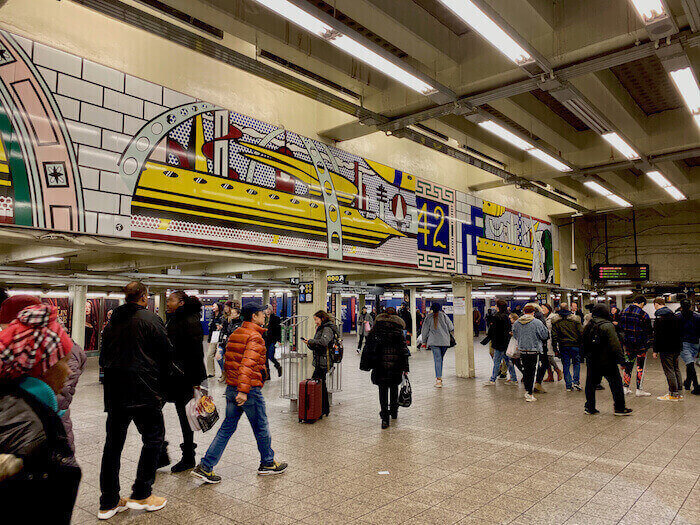
A walk around the mezzanine reveals a lot more hidden NYC attractions. Near the 7 train on the mezzanine, you’ll find two murals, the Onset of Winter and The Return of Spring. They were created by Jack Beal, an American realist painter. Chances are you are visiting NYC in or near one of these seasons.
Walk by the N/Q/R platform and you’ll see a mural by Jacob Lawrence, one of the best known 20th century African American painters. Some of his works are in the Museum of Modern Art, the Whitney, the Philadelphia Museum of Art and many other museums.
Next, follow the signs to find the corridor between 1/2/3 and the Shuttle (the S). The 35 colorful glass panels embedded in the glass brick wall are called Times Square Times: 35 Times by Toby Buonagurio. She is an up and coming artist from the Bronx known for her colorful ceramics.
Join the Revelers at 42nd Street Port Authority
Port Authority Subway station is another hub for street art. Luckily, the two stations (Times Square and Port Authority) are connected by a long hallway filled with 60+ mosaics by Jane Dickson. Her mosaics shows people in the midst of celebrating New Year’s Eve. It’s called the Revelers.
Her work has been shown at many museums around the world, including in the National Portrait Gallery at the Smithsonian Museum. She uses a lot of interesting materials in her work, including sandpaper, vinyl, AstroTurf. We love the vibrancy of her work and the assortment of ordinary people.
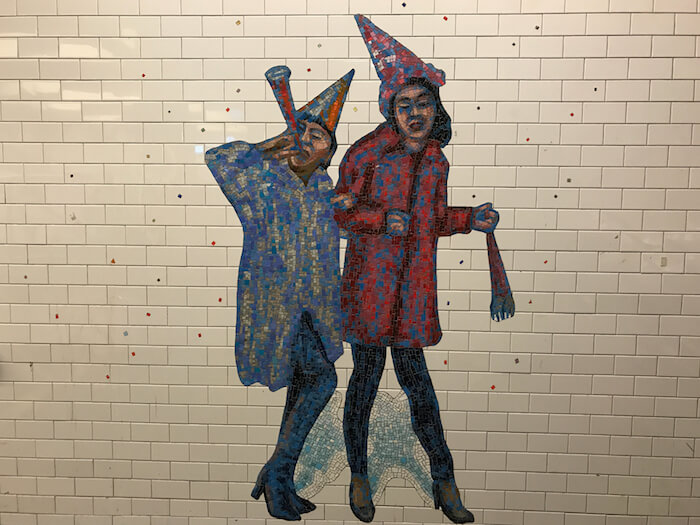
You’ll also see Losing My Marbles by Lisa Dinhofer on the mezzanine near the A/C/E. This mosaic is 90 feet long and stretches over 5 walls. If you’re lucky, you can also see her work at Denise Bibro Fine Art gallery in Chelsea right under the Highline.
If you look up at the ceiling in this hallway, you’ll see a poem call the Commuters Lament by Norman B. Colp.
The Underground Art Museum on the New Q Line
The Q line on the Upper East Side is the newest subway line in New York City. Often referred to as the 2nd Avenue subway by NYC natives, it took forever to build and cost $4.5B USD. It is eventually supposed to connect Lower Manhattan to Harlem.
There are four stops with amazing subway art (63rd & Lexington, 72nd, 86th and 96th Streets).
See NYC History By Jean Shin at 63rd & Lexington
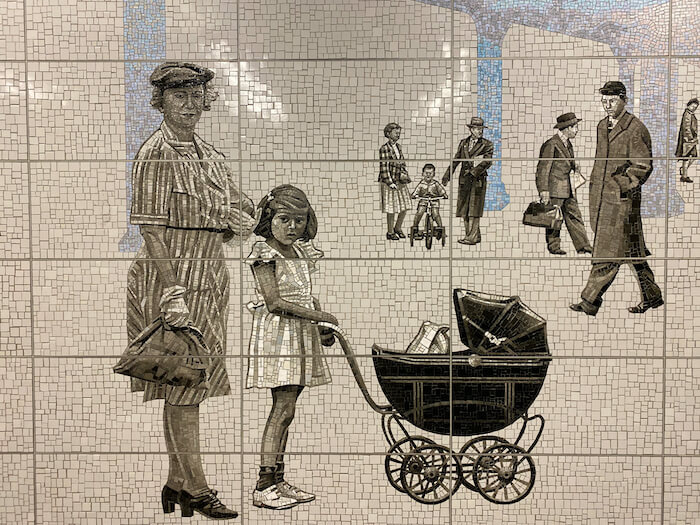
Jean Shin’s work can be seen at the 3rd Avenue entry to the station and on the mezzanine. If you are entering from the street, use the 3rd Avenue entrance and you will be greeted by her mosaic of the de-construction of the old elevated tracks. The El, as it was called, ran over 2nd Avenue and was torn down in 1942.
There are wonderful murals on the mezzanine level based on early 20th century photographs. There are many throughout the station, so walk around the mezzanine and see them all.
In order to see the mosaics, you’ll need to go to the 3rd Avenue side of the station.
Meet Perfect Strangers at 72nd Street
Perfect Strangers is one of the must-see works in the NYC Subway. Native Brazilian Muniz created portraits of people in his life, ranging from his orthodox Jewish accountant to a man in a tiger costume. He even included a LGBTQ couple.
The mosaics are playful, endearing and touching. Ordinary people. Perfect strangers. They all ride the subway together in NY.
You’ll want to get off the train and spend some time on the mezzanine with these stunning mosaics.
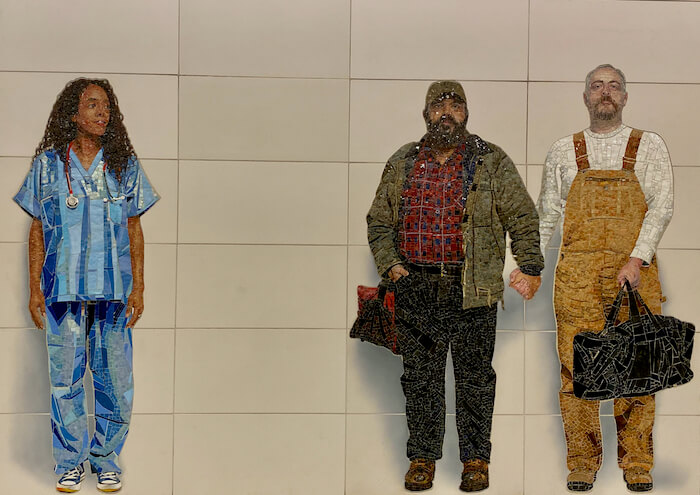
Muniz’s work can also be found in the collections of the Metropolitan Museum of Art, the Los Angeles County Museum of Art, and London’s Victoria and Albert Museum.
Get Up Close to Chuck Close at 86th Street
86th Street is another station that you will want to spend some time in. Chuck Close’s Subway portraits are large and stunning. You’ll find portraits of Philip Glass, Kara Walker, Cecily Brown, Lou Reed and others. As is customary for Close, two of the panels are self-portraits. Most are on the mezzanine with one outside of the turnstiles.
The mosaics and the expressions of the subjects are very intimate. Close has sold works of art for nearly $5 million. His work is on exhibit in major museums all over the world. Don’t miss a chance to get up close with his mosaics.
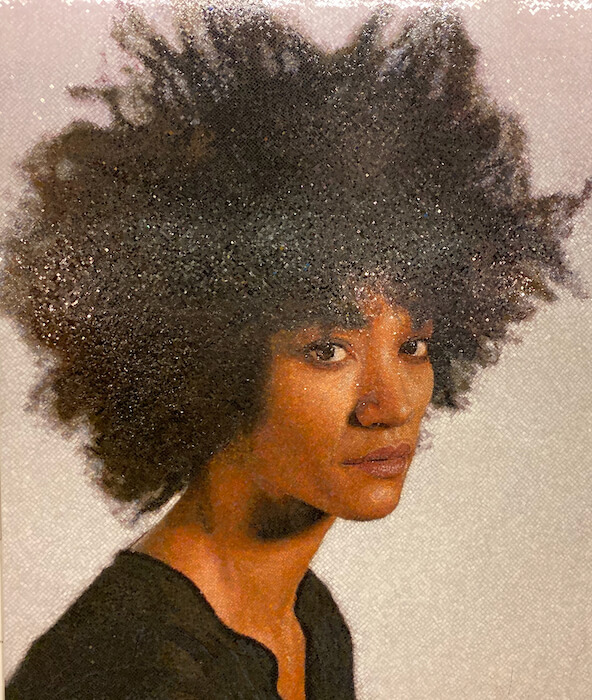
See Blueprint for a Landscape by Sara Sze at 96th Street
Sara Sze’s mural spreads out across the walls of the mezzanine at the 96th street station and outside of the turnstiles. The blue and white mosaic looks like paper flying in the air. Outside of the turnstiles, you’ll see that they turn into birds.
Sze teaches visual arts at Columbia University. She creates large scale installations and was the recipient of a MacArthur Genius Award. She also represented the US at the most recent Venice Biennial.
Experience Funktional Vibrations at Hudson Yards
Hudson Yards has a very vibrant mosaic on the ceiling by Xenobia Bailey called Funktional Vibrations. Bailey is an African American Artist. You will find her work at the Schomburg Center for Research in Black Culture and the Museum of Arts and Design in New York City.
If you are walking the northern part of the Highline or visiting the Vessel in Hudson Yards, make sure to duck into the station to see the mosaics. You can see some of them without going through the turnstiles.
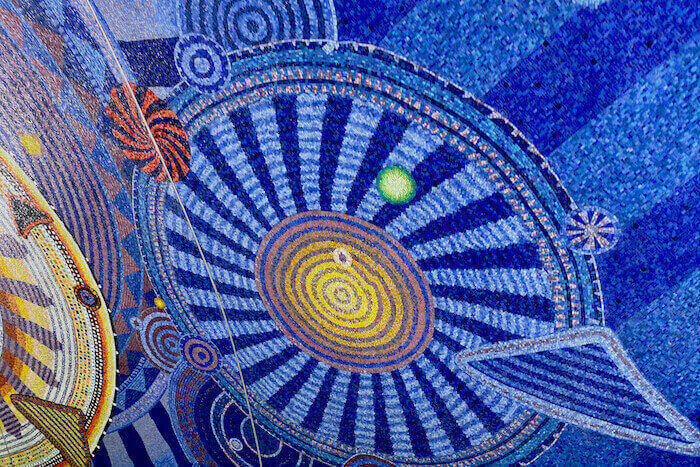
Pay Tribute To Faith Ringgold And The Heroes & Heroines Mosaic in Harlem
There is very good subway art in many of the stations on the Upper West Side and Harlem. Many were created by important African American Artists and leaders, including Faith Ringgold, Vincent Smith and Willie Birch.
Faith Ringgold is a performance artist, painter, writer, sculptor and quilter. She is a very important leader in the effort to support and increase the prominence of African American and women artists. She’s been on the front lines of the feminist and anti-racist movements since the 1970s.
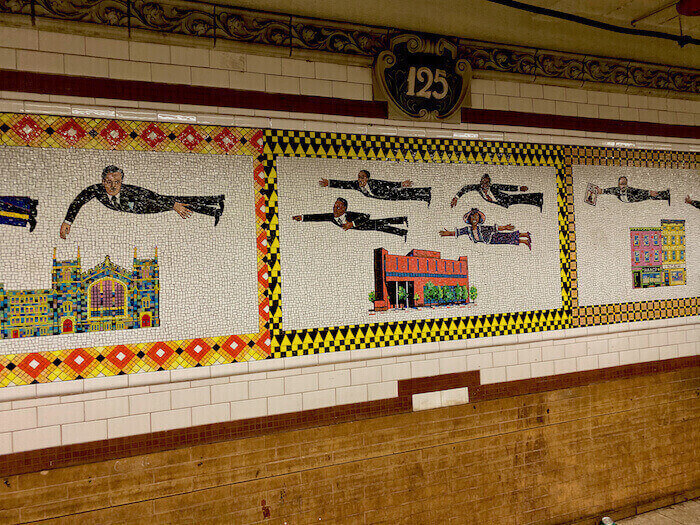
This mosaic is a tribute to Harlem’s famous people. You’ll want to see both platforms—one features political and cultural heroes like Malcolm X and Zora Neale Hurston while the other side has sports figures and performers like Sugar Ray Robinson and Dinah Washington.
There are three trains lines with mosaics. The local line is the 1 and the express lines are the 2 and 3. You can see art all the way up to 148th Street on the 2/3 line.
Vincent Smith Mosaic At 116th Street Station
Vincent Smith was a printmaker, painter and teacher. His work focused on the lives of African Americans. At the 116th Street, he has mosaics on both the downtown (Movers and Shakers) and uptown (Minton’s Playhouse) sides.
On the way uptown, take a moment to see Willie Birch’s mosaic at 135th Street. You’ll find Langston Hughes, Charlie Parker, Thelonious Monk and others in this colorful and historic work.
Meet William Wegman’s Dogs at 23rd Street
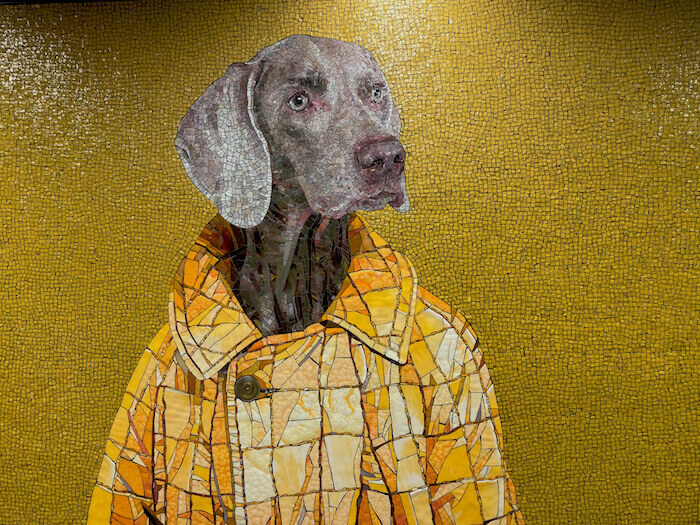
In the 23rd Street Station, William Wegman has a series of 11 wonderful mosaics featuring his Weimaraner’s (named Flo and Topper). You can see the first of the dogs (in a raincoat) in the uptown stairway on the eastside before the turnstiles. The rest are on the platforms.
Make sure to take some time to see the free street art above ground or the Chelsea neighborhood while in in New York.
Go to Spanish Harlem to See Neo-Boriken by Nitza Tufino
Nitza Tufino is a Puerto Rican and Mexican artist. Her Neo-Boriken mural evokes traditional Puerto Rican heritage, including Taino designs. It connects to the Latinx community that lives in the surrounding area of Spanish Harlem.
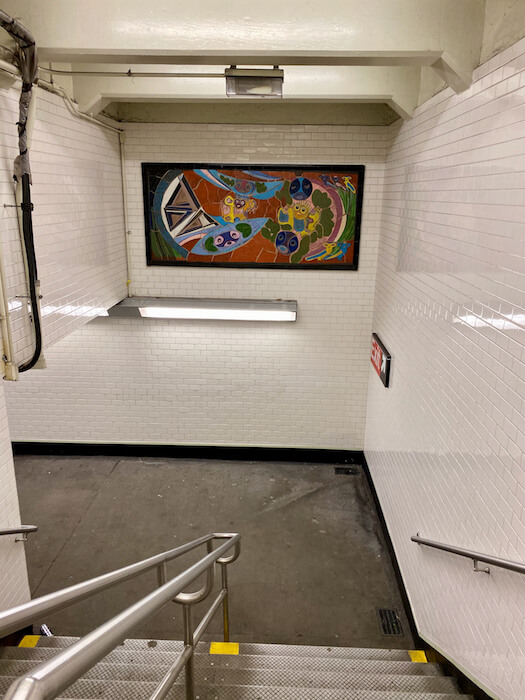
72nd Street on B Sky by Yoko Ono
Yoko Ono’s Sky murals (there are 6 to see) bring clouds and blue sky underground. If you are planning to visit John Lennon’s Memorial at Strawberry Fields in Central Park, make sure to spend some time in this subway station.
Fulton Street Mosaics from 1913 by Frederick Dana Marsh
The Fulton Street Station in the Financial District features a series of murals by Frederick Dana Marsh. These murals were created in 1913 for the McAlpin Hotel in Herald Square. When the hotel was turned into a condominium, the ceramic tiles were removed and given to the MTA. They were put back together by college interns and then installed in the subway in 2000.
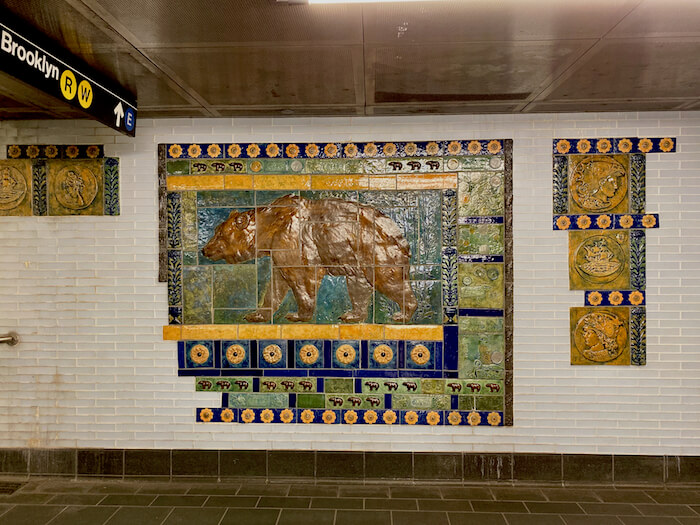
14th Street (A/C/E) Life Underground Tom Otterness
Life Underground is a series of sculptures all over the A/c/e 14th Street. The sculptures at first look funny and whimsical. At a closer glance, however, you’ll see that most of the deal with political corruption and greed. Otterness based the sculptures on the works of 19th century political cartoonist Thomas Nast. Nast was protesting the corruption of Tammany Hall and Boss Tweed, a New York City politician and party boss. You’ll see an alligator feasting on a businessman, a woman worker sitting on top of a businessman and much more.
These sculptures by Tom Otterness are located on the platform and the mezzanine of the A/C/E station at 14 street and 8 Avenue. The ones on the platform are the best. [/et_pb_text][et_pb_text admin_label=”Subway Art Tour” _builder_version=”4.0.11″]
NYC Subway Art Tour
First go to Port Authority to see all of the mosaics there and then go through the corridor to Times Square.
After that, you have 2 choices—you can either go up the West Side or go over the East Side.
West Side
Take the 1/2/3 up to Harlem (you can stop station by station all the way up to 148th Street and then turn around (free transfer).
This line will give you a chance to see some older murals and the work of African American artists.
East Side Q Train Platforms
Going on the East Side tour will bring you to the mosaics on the new Q subway.
From Times Square, take the 7 over to the 4/5/6 and take the Lexington Avenue line to 63rd and Lexington. This gives you a free transfer to the Q train.
Make sure to see Jean Shin’s work before you get on the Q. You’ll need to go to the mezzanine on the 3rd Avenue side of the station. Take the Train uptown and get off at 72nd, 86th and 96th Streets. The murals are on the mezzanines so you have to get off the train to see them.
If you want to see Neo-Boriken, exit the station at 96th Street and walk two avenues west and up to 103rd Street to get to the 6 train. You can then take the 6 downtown.
This itinerary does not include Yoko Ono (72nd Street on the B/C), Tom Otterness (14th Street on the A/C/E), Xenobia Bailey (Hudson Yards) or William Wegman (23rd Street on the F line).
6 Tips for Your NYC Subway Mosaics Tour
Timing Your Trip
1. Since you’ll be getting off at each stop to view the murals, the tour can take a while if there is a lot of time between trains. Take note of the automated signs that tell you how long before the next train so you don’t miss the next train by just a few seconds.
2. We recommend doing the tour just before or after rush hour. During rush hour the trains will be crowded but come more frequently. The downside to going when the trains are crowded is that there will be many people standing in front of the mosaics. Consider starting at 9:30 am (just after the morning rush) or at 3:30 (just before the evening rush).
Subway Etiquette
3. People will move if you tell them (politely) that you are trying to take a picture. The platform may clear out as people get on the train that you just got off. Wait a moment and the platform may clear.
4. You may be tempted to jump off the train to see the mural and jump back on before the doors close. You can do this, but you will not have a very gratifying experience. And, you won’t be able to take very good pictures. Take your time and be with the mosaics.
5. Make sure not to block the traffic flow—New Yorkers really don’t like that.
6. In many places, the lighting and the angles are not very good for taking photos. Sometimes you can get a good shot from across the platform when the train leaves.
Enjoy your tour of New York City Subway Art. We hope that you enjoyed learning about some of the NYC subway secrets and some of the best subway stations in NYC.
There is so much more than we were able to list here. Keep your eyes out if you go to the Museum of Natural History and many other places in New York City. There is art everywhere.
And, while you are topside—on the streets—lookout for street art in Chelsea, Brooklyn, the Lower East Side and elsewhere.
Consider a side trip to Salem, Massachusetts to see street art as a community development project.
Where’s Your Favorite Subway Art In NYC? Other Cities? We’d Love To Hear About Subway Art Around The World.
Travel for Life Now is a participant in the Amazon Services LLC Associates Program, an affiliate advertising program designed to provide a means for sites to earn advertising fees by advertising and linking to amazon.com. Amazon and the Amazon logo are trademarks of Amazon.com, Inc. or its affiliates.
Please Pin and Share
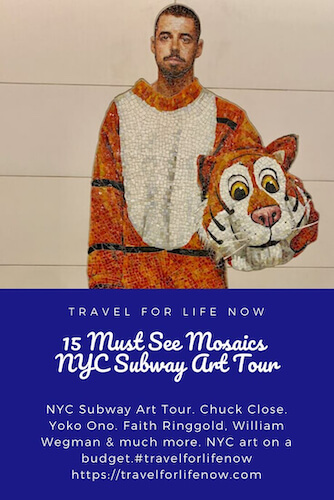
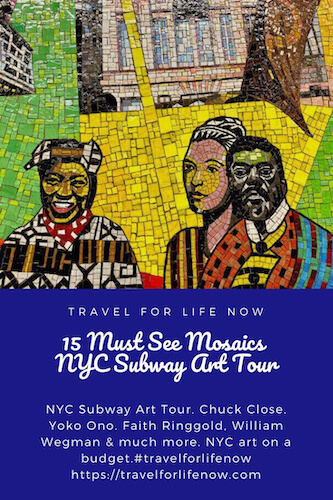
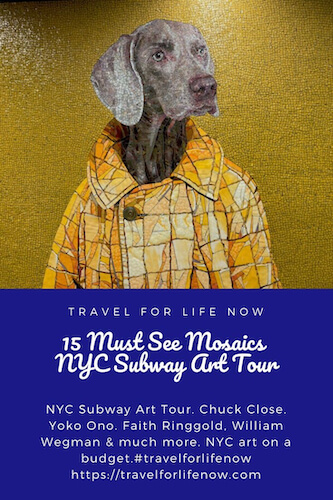

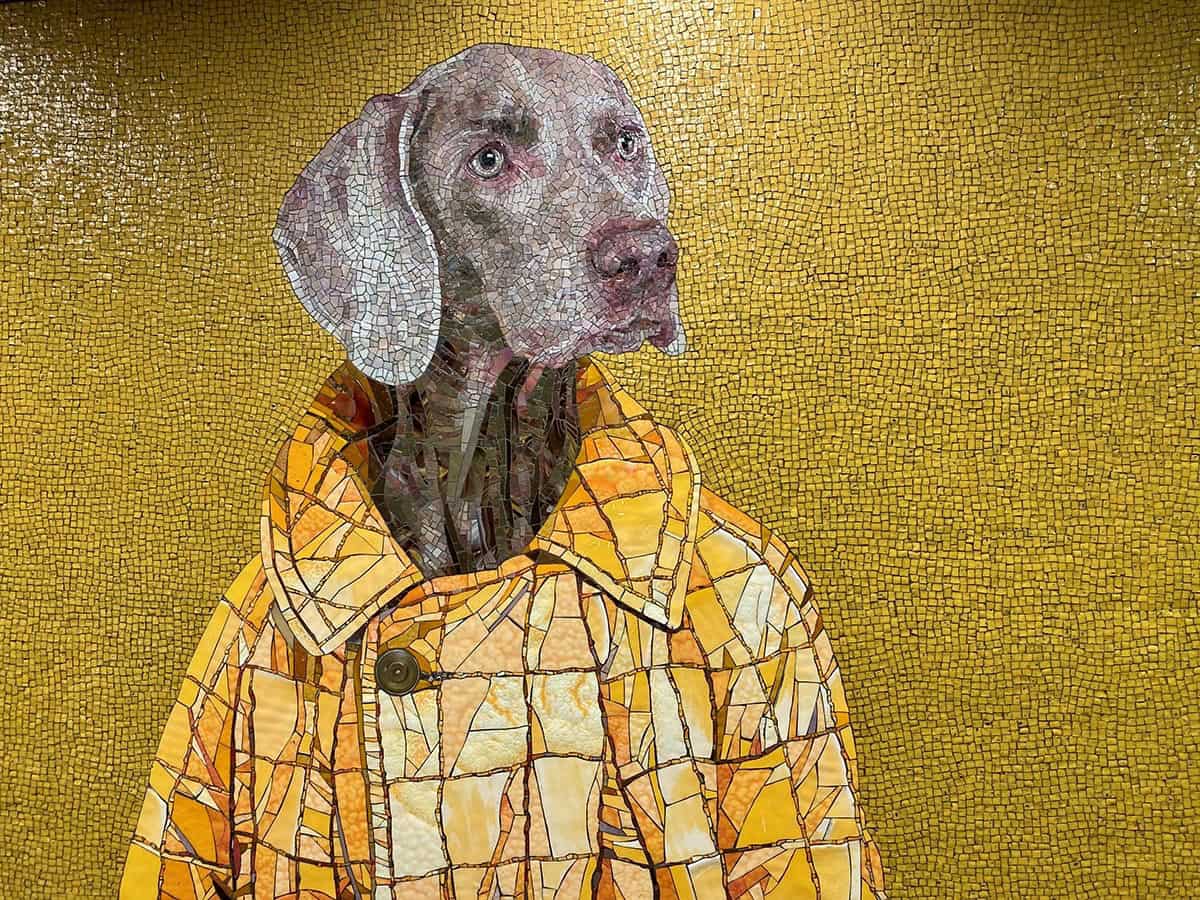
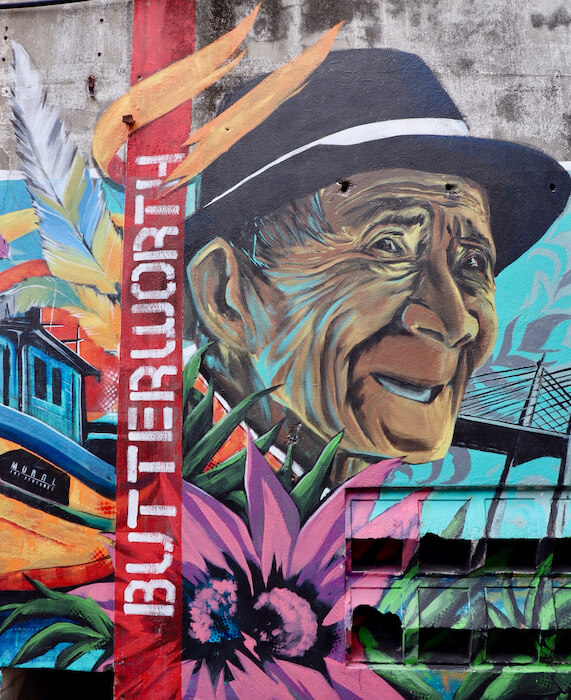

I had no idea that there were so much art in the subways!
Especially like the one with William Wegman 🙂
I didn’t know these existed! How cool. I will have to check them out the next time I’m in NYC!
Erin,
I have lived in NY for decades and never noticed them until now. Thanks for commenting.
Sue
My mum used to create mosaic images but they were nothing like this! I can really appreciate the small size of the pieces to get the details and the shading – amazing artwork!
Ha! I’ve lived in NYC most of my life and apart from the Fulton Street and Q at 86th street stations I didn’t know about any of the others wow! Thanks for this.
Heather,
Me, too. SO easy to be rushing for the subway and not even notice.
Sue
Love this !
I’m actually looking for a mosaic artist.
This is helpful to see who was behind the beautiful works.
Oh I loved this! I had no idea. I will remember it for sure if I ever get back to NK – I have not given up hope!
Alison,
I had no idea too and I live in NYC! Hope that you get back here.
Sue
A fantastic blog post, thanks. The art in the underground of Sydney is also stunning, have you seen that? I’ve shared this with my brother-in-law who lives in NYC. I wonder if he’s seen it?
We mainly travel into cities on our electric bikes (leaving our motorhome parked outside) and miss this sort of thing. Now I will have to make an effort to look at the different subways because clearly we are missing out!
This is an awesome tour! I love street art! I can’t believe there are Lichtestein and Wegman’s in the subways and I didn’t know it!!!!!! I am pinning it for the next time I am in NYC! Thank you so much for your attention to detail.
Nina,
I live in NYC and I didn’t know about all the art in the subway until recently. There are some beautiful pieces and much more than what was included in this post. Let me know when you do come and what you discover.
Sue
Happy blog post, thanks. The underground art scene in Sydney is also pretty cool, have you noticed that? I reported this to my brother who lives in NYC. I think he saw it?
Komal,
I haven’t been to Sydney yet, but will someday check out the art scene. Glad you enjoyed the post and shared it with your brother.
Sue
The mosaics are really impressive. Real art!
Thanks, Darek. They are wonderful to see in person.
Sue
Oh I loved this!
There are a lot of amazing and eye catching mosaics underground in different subway stations. I have seen many. Of course I don’t have too much of a taste for the kind of abstract “poster” type of art such as that very long mosaic that looks like long legs with shoes on that is on one wall at the Lexington and 51st Street station in Manhattan and also the 23rd Street Ely Avenue station in Queens, (no offense) and it is not just that it is abstract but does not really have a dimensional and optical illusion type of element to it.
There is a really amazing mosaic at or near the Queens Plaza station (one of the underground stations ) which shows a blue sky with some white clouds and the mosaic has the images of some older types of buildings, water towers, and abandoned huge billboard frames. The mosaic seems to depict the city during an older time, maybe the 1940s. The station actually the depictions of Long Island City on more than one wall. It evokes a very nostalgic feeling. The mix of art work and historic artifacts at the 81st Street Museum of Natural History station is amazing too.
There are other works of art in subway stations that I have found to be enchanting in some way or other. The Lexington Avenue and 61st Street station is also amazing.
However, I imagine most people who pass by these artworks do not pay much if any attention to them especially regarding commuters who pass by the same artwork regularly. Also the fact that many train stations are poorly maintained, are defaced with graffiti and vandalism, and have homeless people loitering, sleeping, camping in certain areas of the subway stations, and the smell of garbage, and human excrement just makes it hard to let certain art work work its magic on the psyche. Also the fact that dangerous people and situations can always be found in the NYC subway system.
New York has its challenges–poverty–being among them. There is much beauty to find in the city.